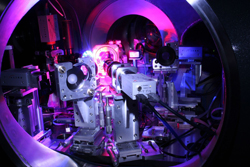New research facility for extreme light science
Among the important by-products of work in 'relativistic optics' has been a new generation of electromagnetic tools, including X-ray and gamma ray beams. The wealth of discoveries these have made possible has convinced scientists of the potential value of pushing even further, into 'ultra-relativistic optics'. The new extreme light infrastructure facility (ELI) is being prepared by the 'Extreme light infrastructure preparatory phase' (ELI-PP) project. ELI will make it possible for researchers to produce ultra-short pulses of high-energy photons, electrons, protons, neutrons, muons and neutrinos on demand. Furthermore, all of this would take place, astoundingly, on very short timescales of the femtosecond and attosecond range (10 to the minus 15and 10 to the minus 18 seconds). Such work will allow scientists to begin to unravel extremely short time-scale dynamics in atomic, molecular and plasma physics. ELI-PP is a collaborative project, bringing together 13 European countries and representing 4 specific research branches. First, ultra-high field science explores laser-matter interactions in an energy range where relativistic laws may no longer be valid. Second, attosecond laser science involves temporal investigation of the electron dynamics in atoms, molecules, plasmas and solids on extremely small time scales. Third, photonuclear science investigates basic scientific issues as well as the applications of high intensity laser beams and gamma rays with atomic nucleus. Finally, high-energy beam science is devoted to the development and use of beams of high-energy radiation and particles near the speed of light. One of the most important objectives of ELI-PP was to decide on the facility's location. After careful consideration, three sites were chosen – in the Czech Republic, Hungary and Romania. A fourth site will be commissioned in a location still to be named. ELI will be the first distributed research infrastructure of such a dimension to be located in any of the EU's New Member States from central and eastern Europe. As such, it represents a significant contribution to Europe's scientific and economic integration and cohesion. A strong interest has also been shown by countries outside the EU in contributing to ELI's scientific programme. These include China, India, Japan, Russia, South Korea and the United States. ELI stands to revolutionise fields such as laser and particle accelerator engineering, nuclear pharmacology, oncology, and X-ray and gamma ray imaging. A dynamic programme of technology transfer will ensure that the results of its work make a difference to scientists and citizens everywhere.







